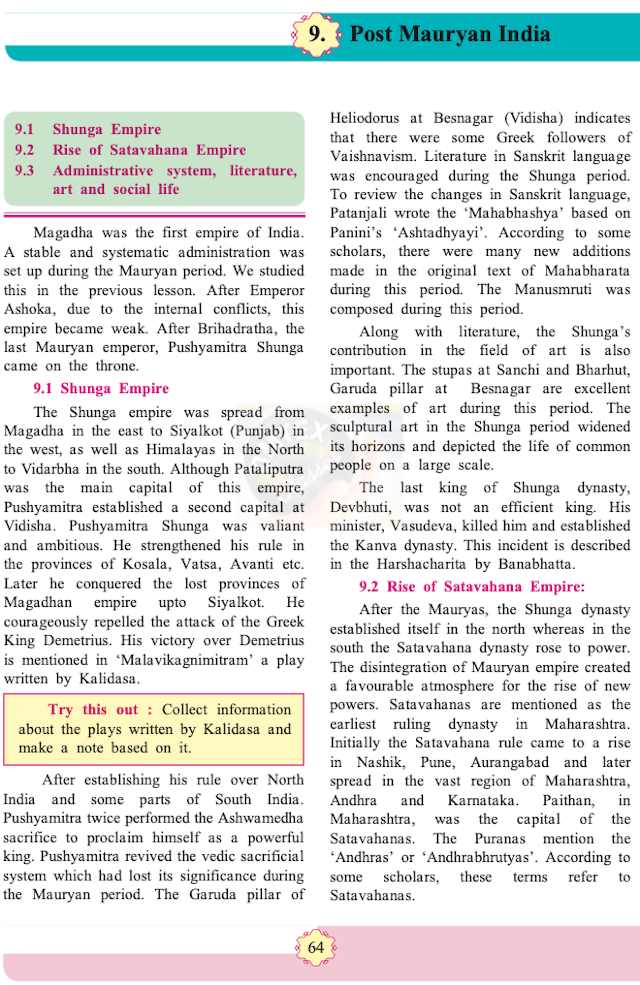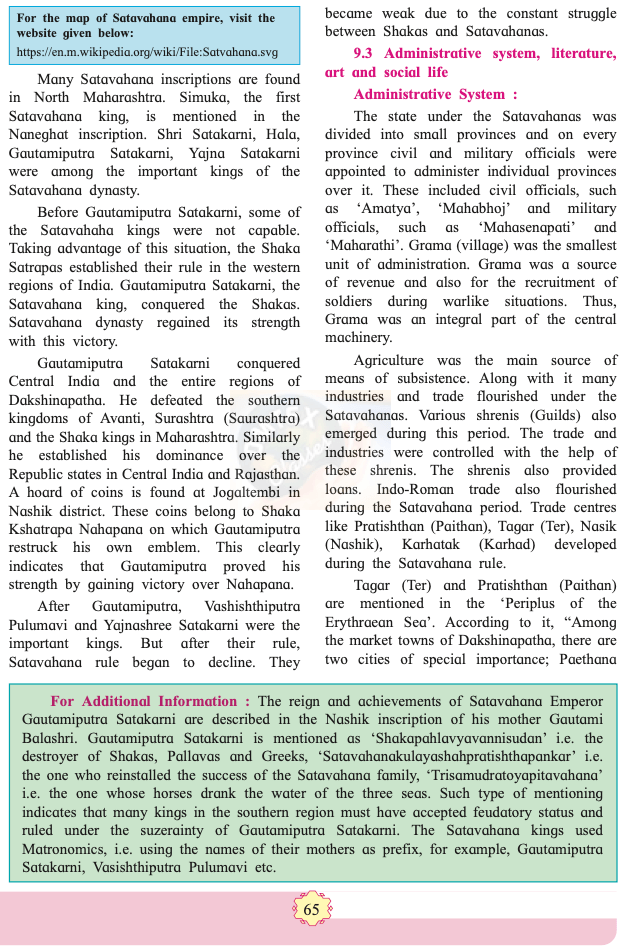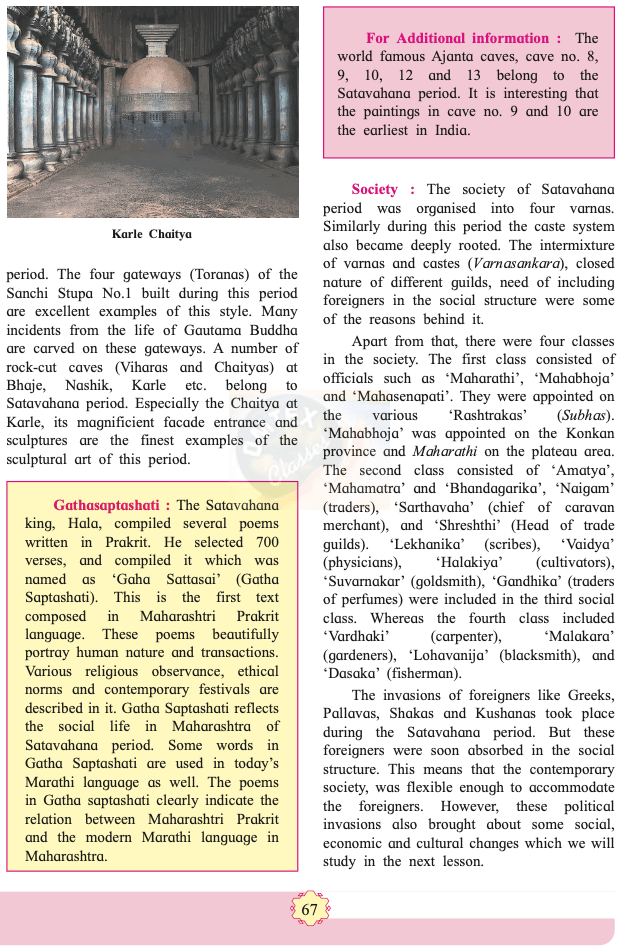Chapter 9: Post Mauryan India
Choose the correct alternative and write the complete sentence.
The last emperor of the Mauryan dynasty was ______.
OPTIONS
Ajatashatru
Chandragupta Maurya
Brihadratha
Emperor Ashoka
SOLUTION
The last emperor of the Mauryan dynasty was Brihadratha.
The Nashik inscription mentions king as ______‘Trisamudratoyapitavahana’.
OPTIONS
Gautamiputra Satakarni
Hala
Yadnashree Satakarni
Simuka
SOLUTION
The Nashik inscription mentions king as Gautamiputra Satakarni ‘Trisamudratoyapitavahana’.
Satavahana king, Hala, compiled ______.
OPTIONS
Brihatkatha
Gatha Saptashati
Katantra
Meghdoota
SOLUTION
Satavahana king, Hala, compiled Gatha Saptashati.
Find incorrect pair from Set B and write the correct ones.
SOLUTION
Explain the following statement with reasons.
During the Satavahana period there was rise of many trade centres.
SOLUTION
During the Satavahana period many industries and trade flourished.
Various shrenis (guilds) emerged during this period.
The trade and industries were controlled with the help of these shrenis. The shrenis also provided loans. lndo-Roman trade also flourished during this period.
Trade centres like Pratishthan (Paithan), Tagar (Ter), Nasik (Nashik), Karhatak (Karhad) during the Satavahana period.
The caste system became rigid during the Satavahana period.
SOLUTION
The society of Satavahanas was organised into four varnas.
The caste system during this period became deep-rooted.
The intermixture of varnas and castes, closed nature of different guilds, need of including foreigners in the social structure were some of the reasons why the caste system became rigid.
Give your opinion.
Prakrit language was encouraged during the Satavahana period.
SOLUTION
Learning and art received royal patronage during the Satavahana period.
Prakrit language and literature flourished during this period.
Hala, the seventeenth king of the Satavahanas compiled 'Gathasaptashati'. Gunadhya, a minister in his court wrote a text 'Brihatkatha ' in Prakrit language named Paishachi.
Thus, Prakrit language was encouraged during the Satavahanas period.
Write short notes:
Nashik inscription of Gautami Balashri
SOLUTION
The reign and achievements of Satavahana Emperor Gautamiputra Satakarni can be found in the Nashik inscription of his mother Gautami Balashri.
Gautamiputra Satakarni is mentioned as 'Shakapahlavyavannisudan' i.e., destroyer of Shakas, Pallavas and Greeks, Satavahanakulayashahpratishthapankar' i.e., one who reinstalled the success of Satavahana family and 'Trisamudratoyapitavahana' i.e., one whose horses drank the water of the three seas.
Naneghat – ancient trade route in Maharashtra
SOLUTION
Naneghat is a mountain pass on the ancient trade route in Maharashtra.
This route connects the ancient town of 'Jirnanagar' (Junnar) and the Kokan province.
Sopara and Kalyan were the most important trade centres in ancient Maharashtra.
Internal as well as foreign trade was carried on from these towns.
Goods imported from Rome were unloaded at Sopara and from there it was carried over to Paithan and Kolhapur.
Gatha Saptashati
SOLUTION
Hala compiled several poems in Prakrit. He selected 700 verses and compiled it and named it as' Gaha Sattasai' (Gatha Saptashati).
This was the first text compared in Maharashtri Prakrit language.
The subject of these poems portrays human nature and transaction.
Various religions observance, ethical norms and contemporary festivals are described in it.
Gathasaptasati reflects the social life in Maharashtra of the Satavahana period.
Write information about the Satavahana dynasty with the help of the given points.
Rise and expansion
Administrative system
Trade and industries
Literature and art
SOLUTION
Rise and expansion : After the disintegration of the Mauryan Empire many new powers arose. Among them the Satavahanas are mentioned as the earliest ruling dynasty in Maharashtra. The Satavahanas ruled over a vast region of Maharashtra, Andhra and Karnataka. Parithan. Maharashtra was the capital of the Satavahanas. The mention of Puranas the Andhras or 'Andhrabhrutyas' Probably these terms refer to the Satavahanas. Simuka was the first Satavahana king to be mentioned in the Naneghat inscription. The most important king of this dynasty was Shri Satakarni, Hala, Gautamiputra Satakarni and Yajna Satakarni. Gautamiputra Satakarni conquered the Shakas and also Central India and the entire regions of Dakshinapatha. He also established his dominance over the Republic states in Central India and Rajasthan. Gautamiputra proved his strength by gaining victory over Nahapana. The Satavahana rule became weak due to the constant struggle between Shakas and Satavahanas.
Administrative system: The state was divided into small provinces. Every province was under civil and military officials. Civil officials such as 'Amatya' 'Mahabhoj' and military officials such as 'Mahasenapati' and 'Maharathi' were appointed. Grama (village) was the smallest unit of administration. Grama was a source of revenue and also for recruitment of soldiers during war like situations. Grama was an integral part of the central machinery.
Trade and industries: Agriculture was the main source of income. Along with it many industries and trade flourished. Various Shrenis(Guilds) also emerged during this period. The trade and industries were controlled with the help of these shrenis. Indo-Roman trade also flourished during the Satavahana period. Trade centres like Pratishthan (Paithan), Tagar (Ter), Nasik (Nashik), Karhatak (Karhad) developed during this period. Cotton cloth, muslin and sack cloth and other merchandise were the terms of trade. Kalyan, Sopara, Bhadoch were important trade centres.
Literature and art: Learning and art received royal patronage. Prakrit language and literature flourished. Hala compiled 'Gathasaptashati'. Gunadhya, a minister wrote Brihatkatha in a Prakrit language called Paishachi. Sarvavarma wrote a treatise on Sanskrit grammar named' Katantra'. A new native Indian style emerged in this period. The four gateways (Toranas) of the Sanchi Stu pa No.1 built during this period are excellent examples of this style. Many incidents from the life of Gautama Buddha are carved on these gateways. A number of rock-cut caves at Bhaje, Nashik, Karle etc., belong to this period. Especially the Chaitya at Karle, its magnificent facade entrance and sculptural are the finest examples of the sculptural art of this period.
Balbharati Solutions for History 11th Standard Maharashtra State Board
• Chapter 2: First Cities of India
• Chapter 3: Chalcolithic Villages in India
• Chapter 5: Janapadas and Republics
• Chapter 6: Second Urbanisation in India
• Chapter 7: India and Iran (Persia)
• Chapter 8: India during Mauryan period
• Chapter 9: Post Mauryan India
• Chapter 11: Kingdoms in South India
• Chapter 12: India, Nations in the northwest of the Indian Subcontinent and China
• Chapter 13: India, Shri Lanka and Southeast Asia
• Chapter 14: Delhi Sultanate, Vijayanagar and Bahamani Kingdom
• Chapter 15: India during Mughal period
• Chapter 16: Swarajya to Empire (Maratha period)
.
Balbharati Solutions for History 11th Standard Maharashtra State Board
• Chapter 2: First Cities of India
• Chapter 3: Chalcolithic Villages in India
• Chapter 5: Janapadas and Republics
• Chapter 6: Second Urbanisation in India
• Chapter 7: India and Iran (Persia)
• Chapter 8: India during Mauryan period
• Chapter 9: Post Mauryan India
• Chapter 11: Kingdoms in South India
• Chapter 12: India, Nations in the northwest of the Indian Subcontinent and China
• Chapter 13: India, Shri Lanka and Southeast Asia
• Chapter 14: Delhi Sultanate, Vijayanagar and Bahamani Kingdom
• Chapter 15: India during Mughal period
• Chapter 16: Swarajya to Empire (Maratha period)
.




